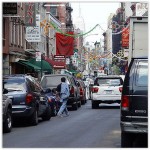 Little Italy is a neighborhood in lower Manhattan, New York City, once known for its large population of Italians. Today the neighborhood consists of only a few Italian stores and restaurants. It is bounded on the west by Tribeca and Soho, on the south by Chinatown, on the east by the Bowery and Lower East Side, and on the north by Nolita.
Little Italy is a neighborhood in lower Manhattan, New York City, once known for its large population of Italians. Today the neighborhood consists of only a few Italian stores and restaurants. It is bounded on the west by Tribeca and Soho, on the south by Chinatown, on the east by the Bowery and Lower East Side, and on the north by Nolita.
HISTORY
Little Italy on Mulberry Street used to extend as far south as Worth Street, as far north as Kenmare Street, as far west asLafayette Street, and as far east as Bowery. It is now only three blocks on Mulberry Street. Little Italy originated as Mulberry Bend. Jacob Riis described Mulberry Bend as “the foul core of New York’s slums.”
Bill Tonelli from New York magazine said, “Once, Little Italy was like an insular Neapolitan village re-created on these shores, with its own language, customs, and financial and cultural institutions.” Little Italy was not the largest Italian neighborhood in New York City, as East Harlem (as Italian Harlem) had a larger Italian population. Tonelli said that Little Italy “was perhaps the city’s poorest Italian neighborhood”. In 1910 Little Italy had almost 10,000 Italians; that was the peak of the community’s Italian population. At the turn of the 20th century over 90% of the residents of the Fourteenth Ward were of Italian birth or origins. Tonnelli said that it meant “that residents began moving out to more spacious digs almost as soon as they arrived.”
After World War II, many residents of the Lower East Side began moving to Brooklyn and Staten Island in New York City, andLong Island and New Jersey. Chinese immigrants became an increased presence after the U.S. Immigration Act of 1965removed immigration restrictions. In 2004 Tonelli said “You can go back 30 years and find newspaper clips chronicling the expansion of Chinatown and mourning the loss of Little Italy.”
Prior to 2004, several upscale businesses entered the northern portion of the area between Houston and Kenmare. Tonelli said “Real-estate prices zoomed, making it even tougher for the old-timers—residents and businesspeople alike—to hang on.” After theSeptember 11 attacks in 2001, areas below Houston Street were cut off for the rest of the fall of 2001. The San Gennaro feast, scheduled for September 13, was postponed. Business from the Financial District dropped severely and residents in Little Italy and theManhattan Chinatown suffered. Tonelli said the post-9/11 events “strangely enough, ended up motivating all these newfangled efforts to save what’s left of the old neighborhood.” In 2004 Tonelli said “Today, Little Italy is a veneer—50 or so restaurants and cafés catering to tourists, covering a dense neighborhood of tenements shared by recent Chinese immigrants, young Americans who can’t afford Soho, and a few remaining real live Italians.” This sentiment has also been echoed by Italian culture and heritage websiteItalianAware. The site has called the dominance of Italians in the area, “relatively short lived.” It attributes this to the quick financial prosperity many Italians achieved, which afforded them the opportunity to leave the cramped neighborhood for areas in Brooklyn and Queens. The site also goes on to state that the area is currently referred to as Little Italy more out of nostalgia than as a reflection of a true ethnic population.
In 2010, Little Italy and Chinatown were listed in a single historic district on the National Register of Historic Places. Little Italy, by this point, was shrinking rapidly.
DEMOGRAPHICS
As of the 2000 U.S. Census, 1,211 residents claiming Italian ancestry lived in three census tracts that make up Little Italy. Those residents comprise 8.25% of the population in the community, which is similar to the proportion of those of Italian ancestry throughout New York City. Bill Tonelli of New Yorkmagazine contrasted Little Italy with the Manhattan Chinatown. In 2000, of residents of the portions of Chinatown south of Grand Street, 81% were of Chinese origins.
In 2004, Tonelli said “Little Italy may always endure as an open-air theme park of nineteenth- and twentieth-century European immigration to the Lower East Side… But you’ll spend a long time in the neighborhood before you hear anyone speak Italian, and then the speaker will be a tourist from Milan.” Tonelli added “You have to slow your gaze to find the neighbors in this neighborhood, because they’re so overwhelmed and outnumbered by the tourists. But once you focus, you can see them, standing (or sitting) in the interstices, taking in the scene, like the group of men, mostly senior citizens, loitering contentedly under an awning on Mulberry Street.”

